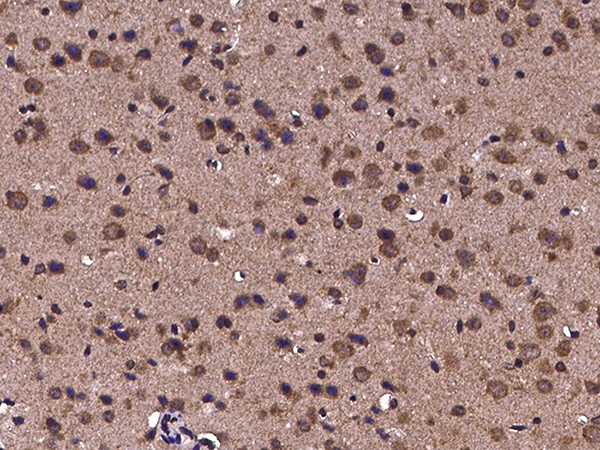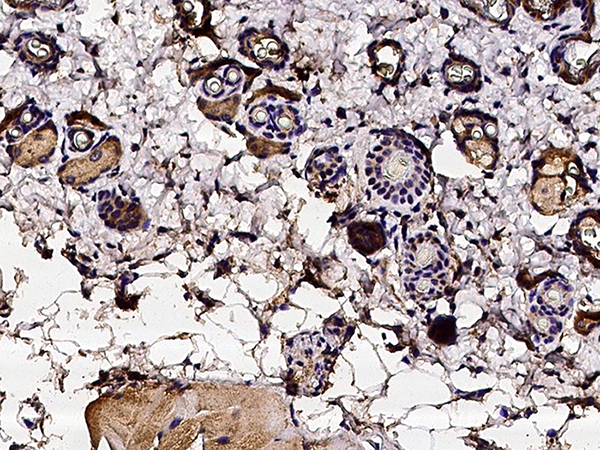-
Product Name
Anti-TNFRSF19/TROY antibody
- Documents
-
Description
Rabbit polyclonal to TNFRSF19/TROY
-
Tested applications
ELISA, IHC-P
-
Species reactivity
Mouse TNFRSF19 / TROY
-
Alternative names
AL023044 antibody; AW123854 antibody; TAJ antibody; TAJ antibody; TAJ-ALPHA antibody; TAJ-alpha antibody; Tnfrsf19 antibody; TNFRSF19 antibody; TRADE antibody; TRADE antibody; Troy antibody; TROY antibody
- Immunogen
-
Isotype
Rabbit IgG
-
Preparation
Produced in rabbits immunized with purified, recombinant Mouse TNFRSF19 (rM TNFRSF19; NP_001157627.1; Met 1-Leu 170). TNFRSF19 specific IgG was purified by mouse TNFRSF19 affinity chromatography
-
Clonality
Polyclonal
-
Formulation
0.2 μm filtered solution in PBS with 5% trehalose
-
Storage instructions
This antibody can be stored at 2℃-8℃ for one month without detectable loss of activity. Antibody products are stable for twelve months from date of receipt when stored at -20℃ to -80℃. Preservative-Free.
Sodium azide is recommended to avoid contamination (final concentration 0.05%-0.1%). It is toxic to cells and should be disposed of properly. Avoid repeated freeze-thaw cycles. -
Applications
ELISA: 0.5-1 μg/mL
This antibody can be used at 0.5-1 μg/mL with the appropriate secondary reagents to detect Mouse TNFRSF19. The detection limit for Mouse TNFRSF19 is approximately 0.00245 ng/well.
IHC-P: 0.1-2 μg/mL
-
Validations

TNFRSF19 / TROY Antibody, Rabbit PAb, Antigen Affinity Purified, Immunohistochemistry
Immunochemical staining of mouse TNFRSF19 in mouse brain with rabbit polyclonal antibody (1 µg/mL, formalin-fixed paraffin embedded sections).

TNFRSF19 / TROY Antibody, Rabbit PAb, Antigen Affinity Purified, Immunohistochemistry
Immunochemical staining of mouse TNFRSF19 in mouse skin with rabbit polyclonal antibody (1 µg/mL, formalin-fixed paraffin embedded sections).
-
Background
Tumor necrosis factor receptor superfamily, member 19 (TNFRSF19), also known as TAJ-alpha or TROY, is a member of the TNF-receptor superfamily. TNFRSF19/TROY expression is detected in the pulmonary epithelium and the ductal epithelium of the prostate and parotid glands. TNFRSF19/TROY expression is detected in some adenocarcinoma cell lines that arise from this tissue. It has been shown to interact with TRAF family members, and to activate JNK signaling pathway when overexpressed in cells. TNFRSF19/TROY is capable of inducing apoptosis by a caspase-independent mechanism, and it is thought to play an essential role in embryonic development. TNFRSF19/TROY was negatively regulated by adipogenic transcription factor CCAAT/enhancer-binding proteins (C/EBP). TNFRSF19 signals activation of the Jnk pathway and induces cell death. Overexpression of TNFRSF19 also signals NFB activation, comparable and similar to that by p75NGFR. TNFRSF19/TROY is capable of activating key signaling pathways of the TNF receptor family, and its predominant expression patterns suggest that it plays a role in the growth and regulation of epithelial tissues.
-
References
- Hu S, et al. (1999) Characterization of TNFRSF19, a novel member of the tumor necrosis factor receptor superfamily. Genomics. 62(1): 103-7.
- Qiu W, et al. (2010) Tumor necrosis factor receptor superfamily member 19 (TNFRSF19) regulates differentiation fate of human mesenchymal (stromal) stem cells through canonical Wnt signaling and C/EBP. J Biol Chem. 285(19): 14438-49.
- Hisaoka T, et al. (2006) Characterization of TROY/TNFRSF19/TAJ-expressing cells in the adult mouse forebrain. Brain Res. 1110(1): 81-94.
Related Products / Services
Please note: All products are "FOR RESEARCH USE ONLY AND ARE NOT INTENDED FOR DIAGNOSTIC OR THERAPEUTIC USE"
